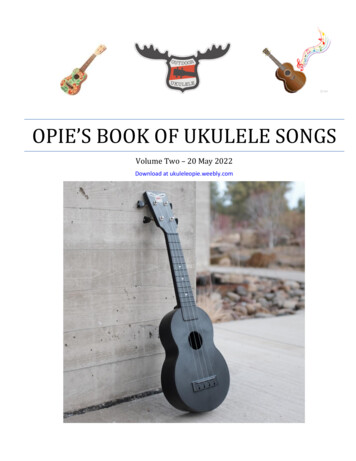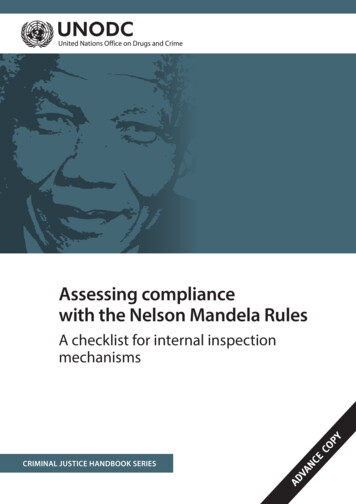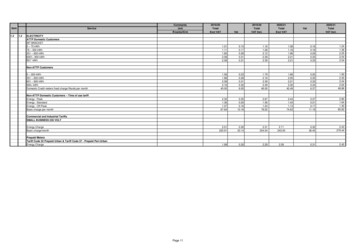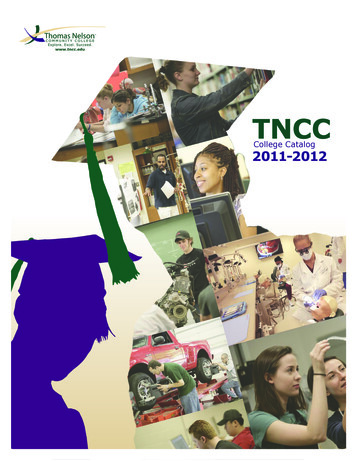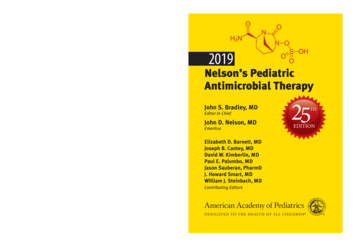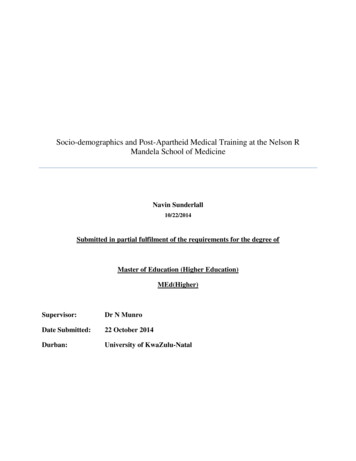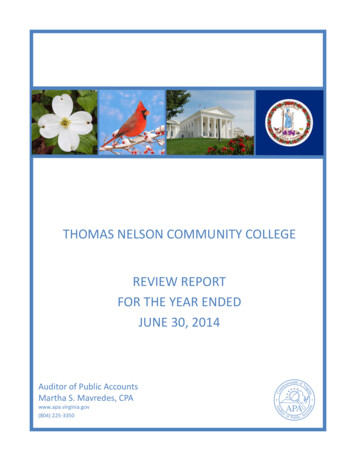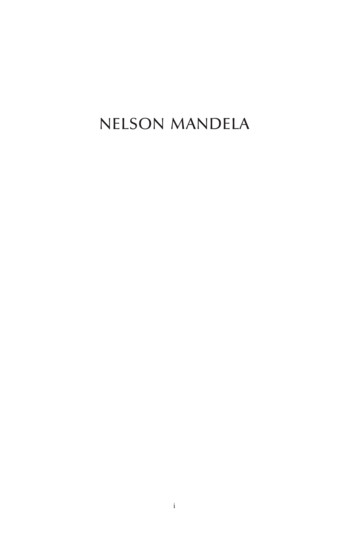
Transcription
NELSON MANDELAi
Recent Titles in Greenwood BiographiesMichael Jordan: A BiographyDavid L. PorterAlex Rodriguez: A BiographyWayne StewartSteven Spielberg: A BiographyKathi JacksonMadonna: A BiographyMary CrossJackie Robinson: A BiographyMary Kay LingeBob Marley: A BiographyDavid V. MoskowitzSitting Bull: A BiographyEdward J. RiellyEleanor Roosevelt: A BiographyCynthia M. HarrisJesse Owens: A BiographyJacqueline EdmondsonThe Notorious B.I.G.: A BiographyHolly LangHillary Clinton: A BiographyDena B. Levy and Nicole R. KrassasJohnny Depp: A BiographyMichael BlitzJudy Blume: A BiographyKathleen Tracyii
NELSON MANDELAA BiographyPeter LimbGREENWOOD BIOGRAPHIESGREENWOOD PRESSWESTPORT, CONNECTICUT LONDONiii
Library of Congress Cataloging-in-Publication DataLimb, Peter.Nelson Mandela : a biography / Peter Limb.p. cm. — (Greenwood biographies, ISSN 1540–4900)Includes bibliographical references and index.ISBN 978–0–313–34035–2 (alk. paper)1. Mandela, Nelson, 1918– 2. Presidents—South Africa—Biography.I. Title.DT1974.L56 2008968.06'5092—dc22[B]2007039787British Library Cataloguing in Publication Data is available.Copyright 2008 by Peter LimbAll rights reserved. No portion of this book may bereproduced, by any process or technique, without theexpress written consent of the publisher.Library of Congress Catalog Card Number: 2007039787ISBN: 978–0–313–34035–2ISSN: 1540–4900First published in 2008Greenwood Press, 88 Post Road West, Westport, CT 06881An imprint of Greenwood Publishing Group, Inc.www.greenwood.comPrinted in the United States of AmericaThe paper used in this book complies with thePermanent Paper Standard issued by the NationalInformation Standards Organization (Z39.48–1984).10987654321iv
For Nicole, and all those who,like Nelson Mandela, opposed apartheidv
vi
CONTENTSSeries ForewordixIntroductionxiTimeline of Events in the Life of Nelson MandelaChapter 1Chapter 2Chapter 3Chapter 4xiiiFamily and ChildhoodEducation and YouthCity of Gold: Law, Marriage, and PoliticsPolitics: Youth League and the African NationalCongressChapter 5 No Easy Walk to Freedom: Defiance of ApartheidChapter 6 On Trial, Winnie, and the “Black Pimpernel”Goes UndergroundChapter 7 The Long Prison Years: Friends, Family, and GlobalSolidarityChapter 8 Free at Last: Release and Transition to DemocracyChapter 9 Presidency and New ChallengesChapter 10 After the Presidency7999109123Glossary131Selected Bibliography133Index137Photo essay follows page 62vii11123334763
viii
SERIES FOREWORDIn response to high school and public library needs, Greenwood developed this distinguished series of full-length biographies specifically forstudent use. Prepared by field experts and professionals, these engagingbiographies are tailored for high school students who need challenging yetaccessible biographies. Ideal for secondary school assignments, the length,format, and subject areas are designed to meet educators’ requirementsand students’ interests.Greenwood offers an extensive selection of biographies spanning allcurriculum-related subject areas including social studies, the sciences,literature and the arts, history and politics, as well as popular culture,covering public figures and famous personalities from all time periodsand backgrounds, both historical and contemporary, who have madean impact on American and/or world culture. Greenwood biographiesare chosen based on comprehensive feedback from librarians and educators. Consideration is given to both curriculum relevance and inherent interest. The result is an intriguing mix of the well knownand the unexpected, the saints and sinners from long-ago history andcontemporary pop culture. Readers will find a wide array of subjectchoices from fascinating crime figures like Al Capone to inspiring pioneers like Margaret Mead, from the greatest minds of our time likeStephen Hawking to the most amazing success stories of our day likeJ. K. Rowling.Although the emphasis is on fact, not glorification, the books aremeant to be fun to read. Each volume provides in-depth informationabout the subject’s life from birth through childhood, the teen years, andix
xSERIES FO REWO RDadulthood. A thorough account relates family background and education,traces personal and professional influences, and explores struggles, accomplishments, and contributions. A timeline highlights the most significantlife events against a historical perspective. Bibliographies supplement thereference value of each volume.
INTRODUCTIONNelson Mandela is the most famous African today. His amazing rollercoaster ride to freedom after 27 years in apartheid prisons to becomepresident of the new “rainbow nation” of South Africa is now legendary.Equally impressive is his successful reconciliation of a deadly conflict seenby many commentators as intractable.In the period of transition from apartheid to democratic rule, and againas South Africa’s first black president from 1994 to 1999, Mandela broughttogether bitter enemies and unified a nation. He did this by leading fromexample with a lack of bitterness at his own long years of imprisonmentunder the apartheid system, and by patiently listening to all sides of thepolitical spectrum, a trait typical of the wise African ruler that he was.How and why was Nelson Mandela able to carry out such majorachievements? What was the secret of his “Madiba Magic”? What werehis motivations? What was the impact on his personal life and his family?What is his legacy today?To understand Mandela one needs to appreciate the rich context of hislife and times. One needs to appreciate his culture, the influence of family,friends, and schools, and the power of the white settler society of SouthAfrica and the regime of apartheid it spawned. Important too are thepeoples he worked with and the movement to which he dedicated his life.To all this, insights into his character and personality, strengths and weaknesses, and the national and global forces of his time are needed finally togain a comprehensive appraisal of his life’s work.Mandela sacrificed much to the struggle for freedom in South Africa,including his very liberty as well as his private life. The goal of Africanxi
xiiINTRODUCTIONfreedom always was his inspiration. His political movement, the AfricanNational Congress, was his support base and vehicle throughout his verylong political career of more than 50 years. In this regard, he was the quintessential “organizational man,” able to build on earlier African politicalstructures to achieve impressive gains. He also was an innovator, an initiator of bold new directions, willing to take political risks. However, inmany ways Mandela does not resemble the stereotypical political leader.Like an earlier subject of this Greenwood Biographies series, ArchbishopDesmond Tutu, Mandela is a humble man of great dignity and humor, example, tolerance, and forgiveness. Both men won the Nobel Peace Prize.Yet even more than Tutu, Mandela in his enforced prison seclusion of27 years was the living legend, the symbol of African resistance to apartheid. For decades, people at home and abroad could neither hear his voicenor see his image; such was the power of his personality and message thatthe apartheid regime banned even his photograph and voice.Mandela would be the first to agree that he and many, many other antiapartheid leaders and supporters combined to remove the apartheid regime,but Mandela stood at the apex of this resistance: the general, the organizer,the African King, the “Father of the Nation” capable of realizing momentoussocial change. Mandela, with his tremendously physical presence, was a manof action willing to take up armed struggle in defense of the freedom andliberty of his people. Even Mandela’s enemies and jailers admired his unflinching courage and dedication. He won a national and global stature equalto none in a period when political leaders have disenchanted many people.Mandela was able to rise above the rigid constraints of the virulent racismof apartheid and the intense bitterness it engendered in many people, but healso was a product of his time and had to face apartheid’s equally bitter socialand economic legacy. He faced this head-on and laid down a democraticconstitutional and political framework seen by many as the most progressivein the world today, and which set a new path for South Africans. Althoughglobal and national forces delayed the realization of some of his dreams,Mandela (or “Madiba” as many South Africans affectionately know him),even after his term as president, remained remarkably active in his late 80s,speaking out for human rights and for action against acute social problems.In the pages to follow, a well-rounded, balanced view of Mandela setsquarely in his time and place is presented. Woven into the biographical narrative are cultural, social, political, and personal forces to let thereader see Mandela in his full complexity, even majesty, and also to sharehis hopes, his victories and defeats, his despair, and his joy, through hisown words and deeds and those of his closest companions and compatriots. Nelson Mandela is quite simply one of the greatest leaders, andpersonalities, in world history.
TIMELINE OF EVENTS IN THELIFE OF NELSON MANDELAJuly 18, 1918 Birth of Nelson Mandela in Mvezo, the Transkei, SouthAfrica1920 Family moves to Qunu village1926 Starts elementary school; given the name “Nelson” byteacher1927 Death of father; Mandela moves to royal court ofThembu Chief Jongintaba Dalindyebo at Mqhekezweni1934 Initiation1935 Starts secondary education at Clarkebury school1937 Higher schooling at Healdtown prep school1939 Studies at University College of Fort HareNovember 1940 Is forced to leave Fort Hare after student protestsApril 1941 Leaves for Johannesburg to avoid arranged marriage1941 Works in Johannesburg; lives in Alexandra; meetsWalter Sisulu1942 Makes contact with the African National Congress(ANC)December 1942 Receives Bachelor of Arts degree from Fort Hare1943 Begins legal studies; joins Alexandra bus boycott1944 Marries Evelyn MaseApril 1944 Congress Youth League is formed; Mandela is a founderAugust 1946 African mine workers’ strikexiii
xivTIMELINE1947 Elected to Transvaal ANC executive committee1948 National Party government elected and starts toimplement apartheid1949 ANC adopts Program of Action1950 Joins ANC National Executive1951 Elected Youth League president1952 Defiance Campaign; Mandela arrested, then banned;becomes president of Transvaal ANC, deputy president of ANC; qualifies as attorney1953 Opposes Sophiatown forced removals; opens legalpractice1955 Congress of the People adopts the Freedom CharterDecember 5, 1956 Charged with treasonJanuary 1957 Evelyn and Mandela separateJune 14, 1958 Marries Nomzamo Winifred MadikizelaMarch 21, 1960 Sharpeville Massacre of 69 Africans by policeApril 8, 1960 ANC and Pan Africanist Congress (PAC) bannedMarch 29, 1961 Mandela and others accused of treason acquittedMay 1961 Organizes “stay-at-home” protestsDecember 16, 1961 Launches sabotage campaignJanuary–July 1962 Travels widely in Africa and to England to gainsupportAugust 5, 1962 Arrested inside South AfricaNovember 1962 Sentenced to three years prison1963–1964 Rivonia TrialApril 20, 1964 Delivers famous speech from the dockJune 12, 1964 Sentenced to life imprisonment; sent to RobbenIsland1969 Winnie Mandela held in prison for 491 days1976 Refuses conditional releaseJune 16, 1976 Student protests in Soweto; countrywide revoltdevelopsMay 17, 1977 Winnie Mandela banished to rural town of BrandfortMarch 31, 1982 Transferred to Pollsmoor PrisonAugust 20, 1983 United Democratic Front (UDF) formed
TIMELINEJanuary 19841985May 1986October 2, 19861987–1988December 9, 1988August 14, 1989February 2, 1990February 11, 1990March 2, 1990March 1990May–August 1990June 1990July 5, 1991December 1991April 1992May 1992September 1992April 1993December 10, 1993April 26–28, 1994May 10, 1994December 1994December 19951996xvRefuses conditional release, and daughter Zindzi readshis defiant response at rally; allowed first contact visitwith WinnieState of emergency; initiates secret talks with governmentMeets Commonwealth Eminent Persons’ GroupU.S. Congress passes Comprehensive Anti-ApartheidActMeetings with government representativesTransferred to Victor Verster PrisonF. W. de Klerk succeeds P. W. Botha as state presidentF. W. de Klerk lifts ban on ANCReleased from prison after 27 yearsReappointed ANC deputy presidentVisits Zambia and Sweden to meet ANC’s exiledleadershipANC–government talks lead to suspension of armedstruggle and release of some political prisonersTours Europe, North America, and AfricaElected ANC presidentCongress for a Democratic South Africa (CODESA)opensSeparation from WinnieANC withdraws from CODESA after “third force”violenceNegotiations resume with governmentSouth African Communist Party (SACP) leader ChrisHani assassinated; Mandela calls for calmReceives, with F. W. de Klerk, the Nobel Peace PrizeANC wins decisive 62.6 percent victory at firstdemocratic electionsMandela inaugurated as South Africa’s first blackpresidentAutobiography, Long Walk to Freedom, launchedTruth and Reconciliation Commission appointedNew constitution adopted
xviMarch 1996July 18, 1998June 2, 1999December 1999January 20052006TIMELINEDivorces WinnieMarries Graça MachelANC wins second term; steps down as presidentDiplomatic role facilitating peace talks in BurundiAnnounces death of son Makgatho, from AIDSAfter voicing criticisms of government, retires frompublic lifeJuly 18, 2007 Aged 89, announces formation of the Elders group
Chapter 1FAMILY AND CHILDHOODNelson Mandela’s childhood and family background helped shape his personality and the views that would be so evident in his later life. Mandela’sown memories and feelings about his childhood, as related in his autobiography, show how influential—at one level—were these years.Mandela’s birthplace was the small South African rural village of Mvezoin the district of Qunu. Although the house in which he was born nolonger exists, this beautiful village still exists today, not very far from thetown of Umtata (Mthatha) in the region known as the Transkei (literally,across the Kei River). The Mandela homestead overlooked the Mbashe(Bashee) River.At first glance, this landscape seems so tranquil: gurgling unpollutedrivers run through rolling hills inhabited by livestock tended by boyshepherds. This is the heartland of the Thembu people, an important section of the Xhosa nation. Here Rolihlahla Madiba Dalibhunga Mandela,later known the world over as Nelson Mandela, was born on July 18, 1918.In these pastoral surroundings, Mandela learned from his family and clanabout his people’s culture and traditions. Later, he would attend Englishlanguage, European-style schools, but as a child, he fully imbibed Xhosaculture, its language, initiation customs, and ideas of leadership andhumanness or ubuntu (a feeling of fellowship and compassion in Africansociety). His given name, Rolihlahla, translates literally as “one who pullsbranches from a tree,” or simply “troublemaker.” His clan name Madiba(“reconciler”) would remain a “praise name” and term of affection used byfriends and compatriots in years to come.11
2NELSON MAND ELAMany African cultures feature extended family structures, with sonsand daughters of uncles and aunts considered as brothers and sisters, notcousins. Mandela’s extended family was no exception. His sister MabelNotancu Ntimakhwe, when interviewed in the 1980s and 1990s, recalledRolihlahla as a serious young boy even then, with “leadership qualities,”and whom people recognized as bright. Another, younger, sister, Leabie,remembers that at the time his sisters called him “Buti.”2Another important feature of Xhosa society was respect for the elders.Such features of African culture, involving a commitment to wider socialwell-being and deference to established leadership, would be recurringthemes in Mandela’s adult life, not least because of his own social status asan integral member of the Xhosa royalty.3Mandela’s father, Gadla Henry Mphakanyiswa (1880–1927) was chiefcouncilor to the paramount chief (or king) of the Thembu people. Xhosanobility have three “Houses,” a Great House from which rulers are traced,the Right Hand House, and a minor or Left Hand House. Mandela wasborn into the Right Hand House and in this regard was very much partof the Xhosa royal family, although his descent-line was not that of theruler. Moreover, he was only the youngest of four sons. However Gadla, aschief advisor to the king, played an important part in decisions, notably ina royal succession dispute in 1924 that was to have an important bearingon Nelson Mandela’s life. Gadla was headman of Mvezo village, in whichcapacity he chaired community meetings and local ceremonies. He alsoserved in the Bhunga, a purely advisory council overseen by the whitegovernment. Given this social prominence, Rolihlahla’s father was a custodian of Thembu and Xhosa history, and he imparted to his son manystirring narratives of African history. Rolihlahla also inherited his father’stall and proud bearing.Mandela’s mother, Nonqaphi Nosekeni Fanny, was the third of hisfather’s four wives. Xhosa men would take more than one wife in accordance with their prosperity, also indicated by the number of cattle theyowned, cattle being the most important form of wealth, used for bridewealth, or dowry payment, upon marriage. Nosekeni had an importantformative influence on her son. Mandela later recalled that his motherwas his “first real friend.”4 She related to him Xhosa moral tales and legends and, after becoming a Christian and taking the name “Fanny,” sheduly ensured that the Methodist (Wesleyan) Church baptized her son.Mandela had three sisters, Baliwe, Notancu (Mabel), and Makhutswana. His father also had three sons and six daughters by other wives.As a boy, Mandela delighted in playing with them traditional games andsports, such as stick-fighting, riding animals, and making toys. The stick-
FAMILY AND CHILDHOOD3fighting game of boys encouraged a sense of honor or magnanimity invictory without dishonoring an opponent, a principle that would guideMandela in later life: “I learned that to humiliate another person is tomake him suffer an unnecessarily cruel fate. Even as a boy, I defeated myopponents without dishonoring them.”5However, these bucolic surroundings of the Transkei where Mandelagrew up disguised deeper troubles about which he would soon learn: landdispossession, colonization, and racism. By the time he was born, Africansno longer owned most of the land, which white settlers now controlled.African women largely worked the land, with their men forced into longand dangerous shifts of migrant labor on the distant gold mines of Johannesburg to be able to pay taxes to the white government. In his earlyyears, rural life effectively quarantined Mandela from these harsh influences. Instead, he was able to learn the customs and traditions of Xhosasociety. Moreover, his social status as a member of the royal line meantthat he was destined for an education and not the working-class life of aminer. Nevertheless, a sudden decline of his father’s material interests andthe warning of elders about the lessons of South African history signaledto Mandela that his life was not likely to be easy.African peoples had inhabited South Africa for many centuries beforeDutch settlement at the Cape of Good Hope in the mid-seventeenthcentury. African nations included the Xhosa, Zulu, Tswana and Sotho,who spoke related languages and were largely agricultural-pastoral peopleswith developed trade networks and complex cultures, as well as the morepastoral or foraging Khoikhoi and San (“Bushmen”) peoples. The Dutchsoon introduced slaves from Southeast Africa and Southeast Asia and,over the next century-and-a-half, steadily conquered African lands. Theprocess of dispossession accelerated after the British took control of theCape Colony during the Napoleonic Wars. As European armies and settlers pushed east, it was primarily the Xhosa people, with their relativelydeveloped social and military systems, that stood in their way. The Xhosawould face more than one hundred years of warfare in a desperate attemptto hold their lands. But by the time of Mandela’s father, this protractedwar was lost. Gadla’s own position as headman was now dependent onthe whim of British officials. Still, the Xhosa lands of the Eastern Capehad by then become the center of an African revival coupled with earlyAfrican nationalism as the indigenous people abandoned methods ofdirect resistance for mission Christianity, education, and new forms ofpolitical organization.The long period of African resistance to European conquest and colonization influenced Mandela’s father and other Xhosa elders from whom
4NELSON MAND ELAthe young Nelson would learn this history. In 1920, when Mandela wasonly two years of age, came a bolt of lightning; the government deposedhis father as headman for alleged insubordination over the small matter ofa local dispute among villagers about a stray ox. His father saw the disputeas essentially one in his own domain, of traditional, chiefly, jurisprudence.As a matter of principle, he refused to acknowledge white power in thissphere. In this regard, Gadla was following precedent: the Thembu Paramount Chief, Dalindyebo (1865–1923), had long intervened in local resource conflicts to challenge white authority. In Mandela’s own words, hisfather was “asserting his traditional prerogative as a chief ” and displaying“a proud rebelliousness, a stubborn sense of injustice”—which Mandelabelieves he inherited.6As a result, the Mandela family lost most of its land and cattle and hadto move to a larger village, Qunu, for the support of kin. Gadla’s act ofbrave, if futile resistance was all the more remarkable given the complexrecent history of the Thembu people who, as historic rivals of the centralXhosa kingdom, had been successively weakened in the nineteenth century by British “divide and rule” strategy that exploited divisions amongXhosa-speaking peoples. As a result, the Thembu had sought some kind ofaccommodation with both Xhosa neighbors and British invaders and theywere perhaps unique among African nations in the region for retention ofa good deal of their lands.It is important to understand the centrality of the land question inSouth African history and how it thus impacted Mandela’s life. Sharedland ownership had been the basis of precolonial African society. Manyyears later, in 1964, Nelson Mandela would state, “The structure andorganization of the original African societies of this country . . . havehad a great influence on my political concepts. . . . The land, which wasthe primary resource in those days, belonged to the tribe as a whole. Private property did not exist.” By the time of Mandela’s father, there wasevidence of the growth of class stratification, with chiefs holding moreland and cattle than commoners, but the principle of sharing remainedwidespread.7Gadla’s action reflected rising African frustration at a time of acutepolitical, social, economic, and environmental crises in the Transkei.In the Act of Union of 1910, when the modern nation of South Africaemerged out of the unification of four colonies, Britain ceded politicalpower only to whites, with most blacks denied the vote. The new whitegovernment embarked on an extensive range of laws that greatly intensified racial discrimination and segregation. In particular, the Natives’ LandAct of 1913 prevented blacks, who comprised more than 80 percent of
FAMILY AND CHILDHOOD5the population, from freely buying land and progressively restricted themto live in the least fertile 13 percent of the country. By World War I,many Thembu enlisted in the British Empire armed forces in the hopeof achieving greater equality at home and abroad, but they were sorelydisappointed when denied even the right to carry arms. After the war,discrimination, far from lessening, increased.Having lost much of their land and all their political power, Africansnow lost control over their very livelihoods, with most of the men fromMandela’s village forced into migrant labor hundreds of miles away onthe gold mines. At the same time, African access to land and forests wasincreasingly restricted,8 while prices rose sharply after the war with nocommensurate increase in black wages. To add to their woes, an influenzaepidemic decimated the population. Culturally, the government deniedAfricans the right to practice many of their traditional customs. All thesefactors help explain the action of Mandela’s father in challenging whiteauthority and set the stage for the development of Mandela’s own ideas.Despite his father’s loss of income and land, Rolihlahla recalls his timein Qunu as the “happiest years of my boyhood.” He played with otherchildren, herded cattle, became adept at stick fighting, and enjoyed sliding down huge, smooth rocks with other boys. Yet great changes in his lifewere afoot. It was in Qunu at the age of seven that Mandela, promptedby his Christian mother and family friend George Mbekela, first went toschool—the first member of his family to do so. He was enrolled in a singleroom mission school where his elementary school teacher, Ms. Mdingane,gave him a British name, Nelson, that stuck. He had to wear his father’sclothes, cut down to size, and his sister Mabel remembers that whereasother children laughed at his scarecrow appearance, Mandela “was determined to get an education.” His education, he later recalled, was one “inwhich British ideas, British institutions, were automatically assumed to besuperior. There was no such thing [to the authorities] as African culture.”Even at this early age, recollects Mabel, Mandela was quick to come to theaid of other people. Once he helped fix the motorbike of a young whiteman, who paid him for the favor. She remembers too that the girls withwhom he sometimes played were older sisters from the senior house.9Not long afterwards, in 1927 at the age of nine, Mandela experiencedanother sharp change in his life as he saw his father die of lung disease. Heleft his mother and moved to the “Great Place” of Mqhekezweni, home ofthe Paramount Chief of Thembuland. A few years earlier in a successiondispute and with the then Paramount Chief Sabata too young to rule,Mandela’s father in his role as royal councilor had ruled in favor of Jongintaba (David Dalindyebo) to serve as regent. Jongintaba, also a member of
6NELSON MAND ELAthe Madiba clan, now returned the favor, agreeing to become guardianof Gadla’s son.Jongintaba groomed Mandela as a future royal councilor. The chief’swife No-England adopted him as virtually her own son. Mandela grewup with the regent’s son, Justice, four years his senior and already activein sports, acting as a close and loving brother and mentor. At the GreatPlace, Mandela enjoyed the company of his new brother. He also playedwith Noma, Jongintaba’s daughter, and Ntombizodwa, the daughter of acousin of Jongintaba, who in the 1980s recollected Nelson as “very wellbehaved and respectful of all the elders,” as well as “diligent and hardworking both with his studies and with the chores that were assigned tohim at the Great Place.” Life was not always easy in rural Mqhekezweni;for instance, it lacked electricity. Nevertheless, many years later Mandelastill treasured how Jongintaba had raised him as his own son.10Mandela’s years at the Great Place impressed upon him the African tradition of leadership and conflict resolution through consensus—“democracy in its purest form” as he later characterized it. At village meetings,every (male) person was entitled to speak, with the chief not above criticism and ruling only after patiently hearing all views. Mandela learned thetechniques of how to become a leader from Jongintaba and elders at theroyal court. The aged Chief Zwelibhangile Joyi taught him about Africanhistory and dispossession of the Thembu at the hands of the abelungu(whites). Mandela recalled, “As a leader, I have always followed the principles I first saw demonstrated by the regent at the Great Place.” He continued to attend a Methodist mission elementary school, studying English,Xhosa, history, and geography, and now regularly attended church with theregent, who later enrolled him in another, higher school at Qokolweni,personally driving him there in his much-prized Ford V8 automobile.11In 1934, at the age of 16, Mandela underwent Thembu initiation rituals to prove his courage so he could make the transition to manhood. Thecircumcision ceremony, still practiced although in different forms today,occurred at the sacred Thembu royal initiation place of Tyhalarha on thebanks of the Mbashe River, secluded from women. The ritual includeddaubing of the body with white clay and the wearing of special clothingmade from natural fibers, and the removal of the foreskin was performedwith an assegai (spear) with no anesthetic: Mandela still remembers thepain that caused him to delay calling out Ndiyindoda (“I am a man”) toaffirm his manhood after the ceremony.The new name given to Mandela after the ritual was “Dalibhunga” or“founder of the Bhunga,” which given his later political leadership, wouldprove prophetic. Although not yet a “political animal,” his interest in
FAMILY AND CHILDHOOD7such matters awakened when, during the ritual, Chief Meligqili addressedthe initiates, or abakhwetha. Despite the promise of manhood in the ceremony, the chief warned the initiates that this was in reality an illusion:For we Xhosas, and all Black South Africans, are a conqueredpeople. We are slaves in our own country. We are tenants onour own soil. We have no strength, no power, no control overour own destiny in the land of our birth. They [the initiates]will go to cities where they will live in shac
Michael Jordan: A Biography David L. Porter Alex Rodriguez: A Biography . The paper used in this book complies with the . Series Foreword ix Introduction xi Timeline of Events in the Life of Nelson Mandela xiii Chapter 1 Family and Childhood 1 Chapter 2 Education and Youth 11 C
